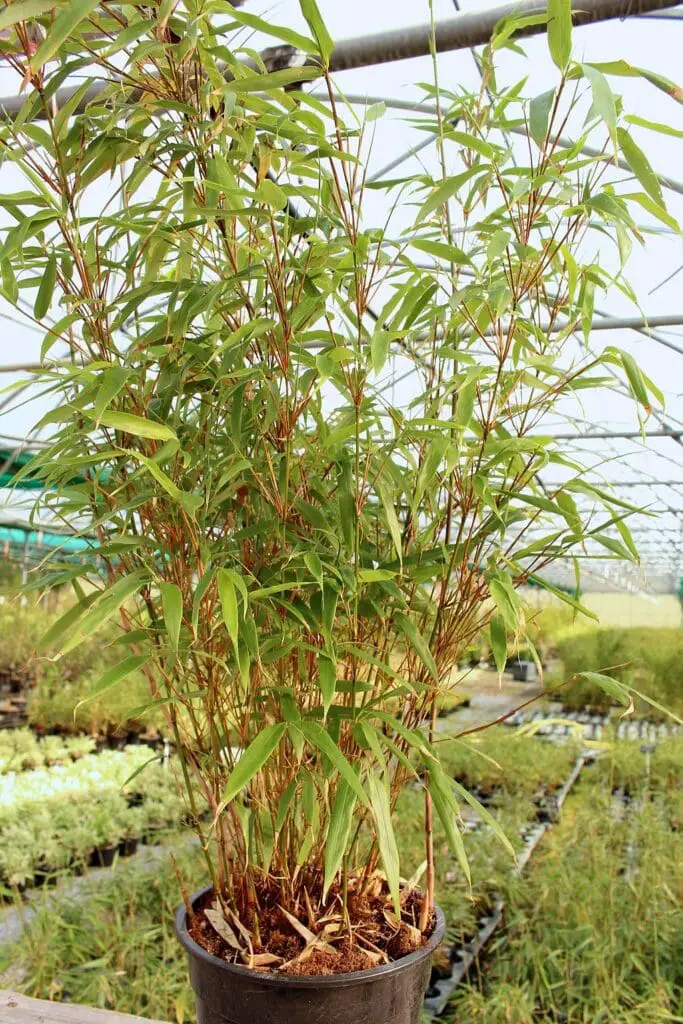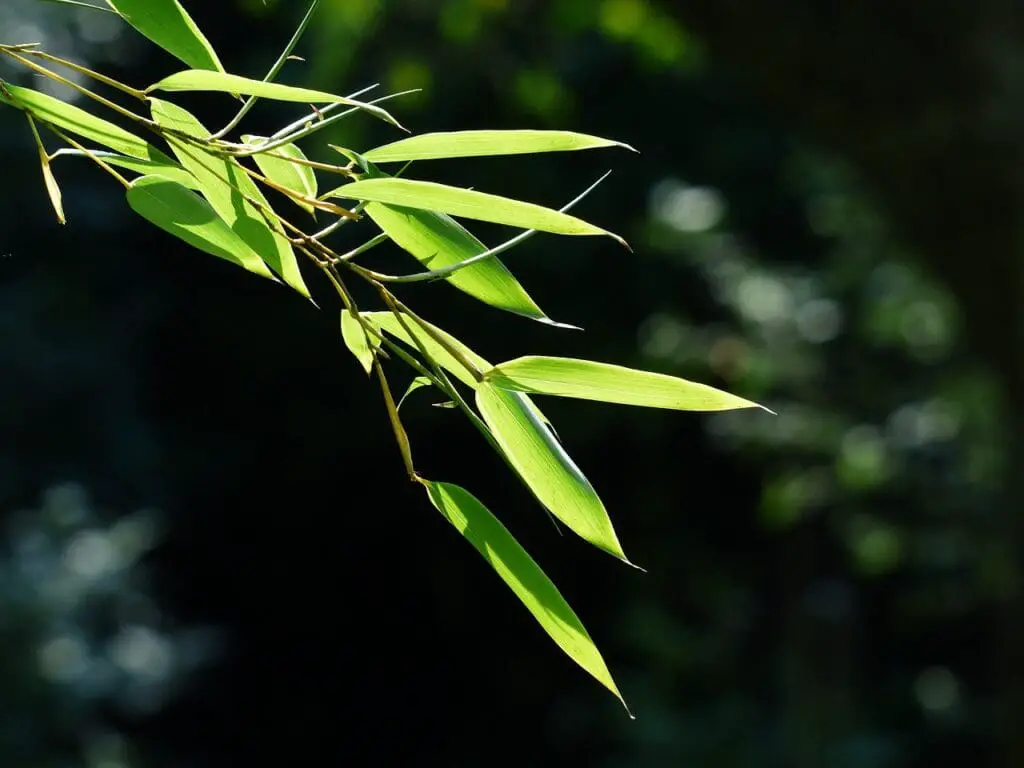Bamboo has the potential to thrive in Connecticut’s climate. However, due to its invasive nature, it is crucial to select suitable bamboo varieties that can withstand the state’s weather conditions without posing a threat to surrounding areas.
Key Takeaways
-
Bamboo can thrive in Connecticut’s climate.
-
Suitable bamboo varieties should be selected to avoid invasiveness.
-
Running bamboo species are prohibited, but clumping bamboo is a non-invasive alternative.
-
Fargesia bamboos like Fargesia denudata, Fargesia rufa, and Fargesia scabrida are recommended for their cold-hardiness.
Growing Bamboo in Connecticut
Connecticut, with its location in USDA hardiness zones 5b to 7b, offers suitable conditions for growing bamboo, but due to the potential invasiveness of running bamboo species and legal restrictions, it is recommended that Connecticut growers opt for cold-hardy clumping varieties such as Fargesia denudata, Fargesia rufa, and Fargesia scabrida.
Bamboo cultivation techniques in Connecticut involve selecting a well-drained site with partial shade or full sun exposure. The best soil conditions for bamboo growth include fertile soil rich in organic matter. Regular watering is necessary during dry periods to maintain optimal growth. Pruning and maintenance of bamboo plants include removing dead or damaged canes and thinning out dense areas to promote airflow.
Benefits of growing bamboo in Connecticut include erosion control, privacy screening, wildlife habitat creation, and aesthetic appeal. However, potential challenges may arise from extreme weather conditions like strong winds or heavy snowfall which can damage the plants.
Suitable Bamboo Varieties
Fargesia bamboos, such as Fargesia denudata, Fargesia rufa, and Fargesia scabrida, are suitable varieties for cultivation in the Connecticut climate due to their cold hardiness and ability to thrive in the region’s growing conditions. These bamboos offer several advantages for those looking to grow bamboo in Connecticut:
-
Cold Hardy: Fargesia bamboos are cold-hardy and can withstand the harsh winters of Zone 5b to 7b.
-
Landscaping Potential: These varieties can be used for landscaping purposes, adding beauty and elegance to gardens and outdoor spaces.
-
Low Maintenance: Fargesia bamboos are relatively low-maintenance plants, requiring minimal care once established.
When growing these bamboos in Connecticut, it is important to consider some tips for successful cultivation. Provide them with well-drained soil, ample sunlight, regular watering during dry periods, and occasional fertilization. Additionally, pruning can help maintain their desired height and shape.

Whether used as privacy fencing or as a decorative element in the landscape design, these cold-hardy bamboos are an excellent choice for Connecticut growers seeking hassle-free bamboo options.
Connecticut’s Climate and Hardiness Zones
Regarding the climate and hardiness zones in the region, it is important to understand the specific conditions in which bamboo can thrive. Connecticut falls between Zone 5b and Zone 7b according to USDA hardiness zones. This means that cold temperatures are a concern for growing bamboo, as some varieties may not tolerate extreme cold.
However, there are suitable bamboo varieties that can handle Connecticut’s climate. Fargesia bamboos, such as Fargesia denudata, Fargesia rufa, and Fargesia scabrida, are recommended for hassle-free bamboo growing in Connecticut. These clumping bamboos are cold-hardy to Zone 5 and can reach different heights depending on the variety. To provide a visual representation of Connecticut’s hardiness zones, here is a table:
|
Hardiness Zone |
Temperature Range (°F) |
|
Zone 5b |
-15°F to -10°F |
|
Zone 6a |
-10°F to -5°F |
|
Zone 6b |
-5°F to 0°F |
|
Zone 7a |
0°F to 5°F |
|
Zone 7b |
5°F to 10°F |
By understanding these hardiness zones and selecting appropriate bamboo varieties, Nutmeggers can enjoy growing bamboo in their Connecticut gardens while maintaining control over its growth.
Running vs Clumping Bamboo
When it comes to cultivating bamboo, understanding the distinction between running and clumping varieties is crucial for successful growth and maintenance.
Running bamboo, while fast-growing, can be invasive and spread outside of intended boundaries. This can lead to difficulties in controlling its growth and potential legal issues in certain areas like Connecticut where there are restrictions on growing running bamboo near property or public right of way.
On the other hand, clumping bamboo is slower growing and non-invasive. It offers several benefits such as being easier to maintain, requiring less pruning, and providing a more contained growth habit. To prevent running bamboo from spreading, using growth barriers such as in-ground barriers is essential.
Connecticut Laws and Regulations on Invasive Running Bamboo
Connecticut has specific laws and regulations in place to control the growth and spread of certain bamboo species. These legal restrictions on bamboo are necessary to prevent the invasive nature of running bamboo from causing damage to property or encroaching on public spaces.
According to the Connecticut Department of Energy and Environmental Protection, it is prohibited to grow running bamboo within 40 feet of a property line or any public right of way without utilizing proper containment measures. To maintain bamboo in Connecticut, it is essential for growers to follow the guidelines set forth by these regulations.
This includes using growth barriers, such as in-ground root barriers, to contain running bamboo and prevent its spread beyond intended boundaries. By adhering to these cultivation laws and regulations, individuals can enjoy growing bamboo while ensuring that it remains controlled and does not pose a threat to the environment or neighboring properties.
Recommended Clumping Bamboo Options
Fargesia bamboos, such as Fargesia denudata, Fargesia rufa, and Fargesia scabrida, are highly recommended clumping bamboo options for growers in Connecticut due to their ability to withstand the cold climate and provide hassle-free cultivation. These varieties offer a range of heights and visual appeal, making them suitable for various landscaping needs.
Here is a table summarizing the characteristics of these clumping bamboo options:
|
Bamboo Variety |
Cold Hardy Zone |
Height Range (feet) |
Characteristics |
|
Fargesia denudata |
Zone 5 |
Up to 20 |
Tolerates cold temperatures well; can reach impressive heights |
|
Fargesia rufa |
Zones 5-7 |
6-10 |
Smaller size with colorful culms; adds visual interest to gardens |
|
Fargesia scabrida |
Zones 5-7 |
12-14 |
Medium-sized bamboo with changing colors over time; suitable for privacy screens |
It’s important to note that while River Cane bamboo is hardy to Zone 5 and can reach heights of up to 25 feet, it should be grown with caution due to its running nature. Control measures such as growth barriers are necessary when cultivating this species.
River Cane Bamboo in Connecticut
River Cane bamboo, a running species native to North America, requires careful cultivation and control measures in order to contain its height and invasive growth tendencies. When cultivating River Cane bamboo in Connecticut, it is important to consider its uses and applications.
River Cane bamboo has various ecological benefits such as erosion control, wildlife habitat creation, and carbon sequestration. Additionally, it can be used for crafts, construction, and furniture making.
To maintain and care for River Cane bamboo, regular pruning is necessary to keep the plant at a manageable height. It is also recommended to install in-ground barriers to prevent the spread of rhizomes beyond intended boundaries.
With proper maintenance and containment measures, River Cane bamboo can be an attractive landscaping option for those who desire its unique characteristics while ensuring that it does not become invasive or pose a threat to surrounding vegetation.
Containment Methods and Tips
Containment methods and tips for managing running bamboo involve the use of growth barriers, such as in-ground installations, to prevent its fast-spreading rhizomes from encroaching on neighboring areas.
Bamboo barriers act as a physical barrier, preventing the underground rhizomes from spreading horizontally. These barriers should be installed at least 30 inches deep and extend above ground by several inches to effectively contain the bamboo.
Regular inspection and maintenance are crucial in controlling bamboo growth. Any shoots or rhizomes that manage to escape the barrier should be immediately removed to prevent further spreading.
Additionally, pruning the above-ground canes can help control the height and density of the bamboo grove.
It is important to note that containment methods alone may not fully eliminate the risk of spread, so careful monitoring and proactive management are necessary to prevent bamboo from becoming invasive in Connecticut’s landscape.
Frequently Asked Questions
Q: Can I grow bamboo in Connecticut?
A: Yes, you can grow bamboo in Connecticut. However, there are a few things you need to consider before planting it.
Q: Is bamboo an invasive plant?
A: Bamboo can be considered an invasive plant if it’s a running bamboo variety. Running bamboo can spread quickly and take over an area if not properly contained.
Q: Can I plant running bamboo in my yard?
A: Yes, you can plant running bamboo in your yard. However, you should take measures to contain its spread, such as installing a rhizome barrier or regularly pruning the roots.
Q: Are there any ordinances regarding planting bamboo in Connecticut?
A: Some towns in Connecticut have passed laws regarding the planting of running bamboo. It’s important to check with your local municipality to determine if there are any restrictions or regulations.
Q: What is the fastest-growing bamboo variety?
A: Phyllostachys (yellow groove bamboo) is known to be one of the fastest-growing bamboo varieties, capable of growing up to forty feet in a single season.
Q: Can bamboo grow beyond my property’s boundaries?
A: Yes, bamboo has the potential to spread beyond your property if it’s a running bamboo variety. It’s important to take preventive measures to ensure it does not encroach on neighboring properties or public areas.
Q: What should I do if my neighbor’s bamboo is encroaching on my yard?
A: If your neighbor’s bamboo is encroaching on your yard, you should communicate with them and discuss ways to contain the bamboo to prevent further spread. If an agreement cannot be reached, you may need to seek legal guidance.
Q: Can I use herbicides to control bamboo growth?
A: Yes, herbicides can be used to control bamboo growth. However, it’s important to follow the instructions provided by the manufacturer and ensure it is safe for use in your specific situation.
Q: Where can I find more information on growing bamboo in Connecticut?
A: The Connecticut Agricultural Experiment Station provides in-depth coverage on growing bamboo in Connecticut. You can visit their website or contact them for more information.
Conclusion
In conclusion, Connecticut provides a suitable climate for growing bamboo, but certain varieties must be chosen carefully to ensure they can thrive in the state’s hardiness zones.
Clumping bamboos such as Fargesia denudata, Fargesia rufa, and Fargesia scabrida are recommended options.
It is important to use containment methods for running bamboo while clumping bamboos offer a hassle-free experience for enthusiasts in Connecticut.

